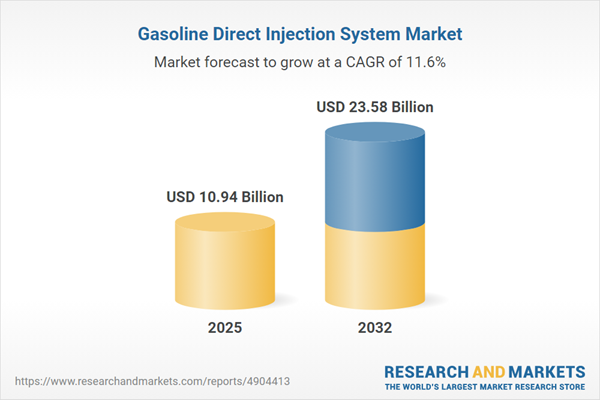Speak directly to the analyst to clarify any post sales queries you may have.
The gasoline direct injection system market is evolving rapidly as automotive companies prioritize stricter emissions compliance, advanced efficiency, and operational agility. Senior decision-makers must respond proactively to regulatory shifts and technological advances to secure growth and sustain market leadership.
Market Snapshot: Gasoline Direct Injection System Market
The gasoline direct injection system market is experiencing robust expansion, underpinned by escalating demands for precision combustion and effective fuel management. This upward trajectory is closely tied to the automotive industry’s focus on digital transformation and the integration of cutting-edge emission control systems. Automakers and suppliers are optimizing manufacturing workflows, incorporating digital compliance platforms, and implementing tailored supply chain solutions to respond flexibly to dynamic regulatory environments. Increased collaboration across regions enables timely deployment of new technologies, helping businesses address regional challenges promptly. Organizational resilience and a commitment to ongoing process improvement ensure continued market relevance as the sector adapts to new standards and consumer expectations.
Scope & Segmentation
- Vehicle Types: Solutions are designed for heavy commercial vehicles, light commercial vehicles, and passenger cars, providing flexibility to meet diverse engineering requirements and evolving compliance standards.
- Engine Displacement: Technology is engineered for engines below 1.5 L, from 1.5 L to 2.0 L, and above 2.0 L. These configurations facilitate technology integration across global markets with varying efficiency targets.
- Injection Pressure Range: Systems are available in high, medium, and low-pressure formats, allowing manufacturers to balance durability, cost, and vehicle performance based on architecture and market positioning.
- Injection Mode: Both single and double injection modes are supported, enhancing fuel management choices and enabling tailored emissions and performance outcomes.
- Sales Channels: Components are procured through both offline and online channels, enabling efficient acquisitions and supporting organizational responsiveness to project timelines and market changes.
- Geographies: The market extends across the Americas, Europe, Middle East & Africa, and Asia-Pacific. This widespread coverage promotes regional adaptation, caters to local policies, and accommodates varied consumer needs.
- Leading Companies: Industry momentum is driven by organizations such as Robert Bosch GmbH, Denso Corporation, Continental AG, BorgWarner Inc., Marelli Holdings Co., Ltd., Hitachi Astemo, Ltd., Keihin Corporation, Mitsubishi Electric Corporation, Aisan Industry Co., Ltd., and Vitesco Technologies Group AG, who are advancing product innovation and sector collaboration.
Key Takeaways for Senior Decision-Makers
- Invest in state-of-the-art fuel and powertrain systems to maintain emissions compliance and elevate product sustainability profiles in line with evolving stakeholder demands.
- Enhance OEM and supplier partnerships to accelerate time to market and maintain operational stability during regulatory or supply chain uncertainty.
- Apply analytics and machine learning tools for ongoing improvements, ensuring greater oversight and optimization in engineering projects and manufacturing operations.
- Adopt predictive maintenance and proactive asset management to extend vehicle platform lifespans and optimize returns across complex technology portfolios.
- Pursue renewable fuel and alternative energy integration for portfolio flexibility and alignment with shifting regulatory landscapes and customer expectations.
- Implement region-specific strategies, with emphasis on Asia-Pacific and North America, to boost supply security and reflect distinct market dynamics.
Tariff Impact: Navigating Policy-Driven Supply Chain Realignment
The rollout of new U.S. tariffs in 2025 requires automotive manufacturers to reconfigure sourcing strategies, emphasizing regionally diversified procurement. This approach supports supply continuity and business stability as firms adapt supply chains in response to updated policy frameworks and evolving international trade dynamics.
Methodology & Data Sources
This analysis is based on executive interviews, regulatory reviews, and a blend of qualitative and quantitative research methodologies. Rigorous industry validation gives senior executives decision-ready intelligence for addressing market opportunities.
Why This Report Matters
- Guides investment toward key advances in gasoline direct injection technology to support innovation initiatives and secure competitive differentiation.
- Improves risk management through digital supply chain monitoring and analytics, building resilience within global, multi-vendor networks.
- Offers actionable frameworks for agile resource deployment, enabling organizations to adapt rapidly to shifting operational demands.
Conclusion
Informed decision-making is essential for market leadership in the gasoline direct injection system sector. Executives leveraging these insights are equipped to navigate complexity and capitalize on emerging opportunities.
Additional Product Information:
- Purchase of this report includes 1 year online access with quarterly updates.
- This report can be updated on request. Please contact our Customer Experience team using the Ask a Question widget on our website.
Table of Contents
3. Executive Summary
4. Market Overview
7. Cumulative Impact of Artificial Intelligence 2025
Companies Mentioned
The companies profiled in this Gasoline Direct Injection System market report include:- Robert Bosch GmbH
- Denso Corporation
- Continental AG
- BorgWarner Inc.
- Marelli Holdings Co., Ltd.
- Hitachi Astemo, Ltd.
- Keihin Corporation
- Mitsubishi Electric Corporation
- Aisan Industry Co., Ltd.
- Vitesco Technologies Group AG
Table Information
| Report Attribute | Details |
|---|---|
| No. of Pages | 183 |
| Published | October 2025 |
| Forecast Period | 2025 - 2032 |
| Estimated Market Value ( USD | $ 10.94 Billion |
| Forecasted Market Value ( USD | $ 23.58 Billion |
| Compound Annual Growth Rate | 11.6% |
| Regions Covered | Global |
| No. of Companies Mentioned | 11 |









